TOYOTA TUNDRA 2010 2.G Owners Manual
Manufacturer: TOYOTA, Model Year: 2010, Model line: TUNDRA, Model: TOYOTA TUNDRA 2010 2.GPages: 724, PDF Size: 13.74 MB
Page 271 of 724
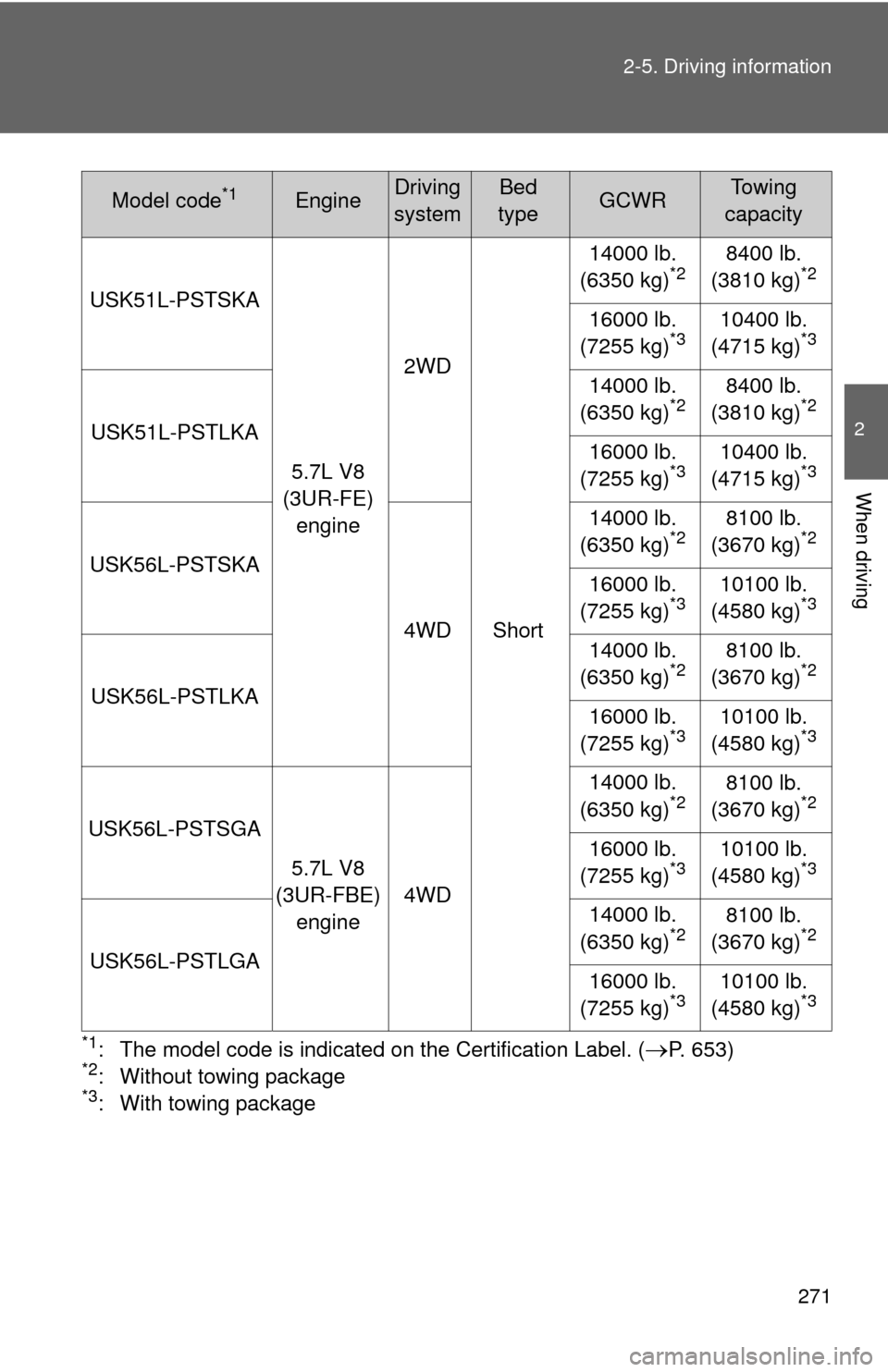
271
2-5. Driving information
2
When driving
*1: The model code is indicated on the Certification Label. (P. 653)*2: Without towing package*3: With towing package
USK51L-PSTSKA
5.7L V8
(3UR-FE) engine 2WD
Short 14000 lb.
(6350 kg)
*28400 lb.
(3810 kg)*2
16000 lb.
(7255 kg)*310400 lb.
(4715 kg)*3
USK51L-PSTLKA 14000 lb.
(6350 kg)
*28400 lb.
(3810 kg)*2
16000 lb.
(7255 kg)*310400 lb.
(4715 kg)*3
USK56L-PSTSKA
4WD14000 lb.
(6350 kg)
*28100 lb.
(3670 kg)*2
16000 lb.
(7255 kg)*310100 lb.
(4580 kg)*3
USK56L-PSTLKA 14000 lb.
(6350 kg)
*28100 lb.
(3670 kg)*2
16000 lb.
(7255 kg)*310100 lb.
(4580 kg)*3
USK56L-PSTSGA
5.7L V8
(3UR-FBE) engine 4WD 14000 lb.
(6350 kg)
*28100 lb.
(3670 kg)*2
16000 lb.
(7255 kg)*310100 lb.
(4580 kg)*3
USK56L-PSTLGA 14000 lb.
(6350 kg)
*28100 lb.
(3670 kg)*2
16000 lb.
(7255 kg)*310100 lb.
(4580 kg)*3
Model code*1EngineDriving
systemBed
typeGCWRTowing
capacity
Page 272 of 724
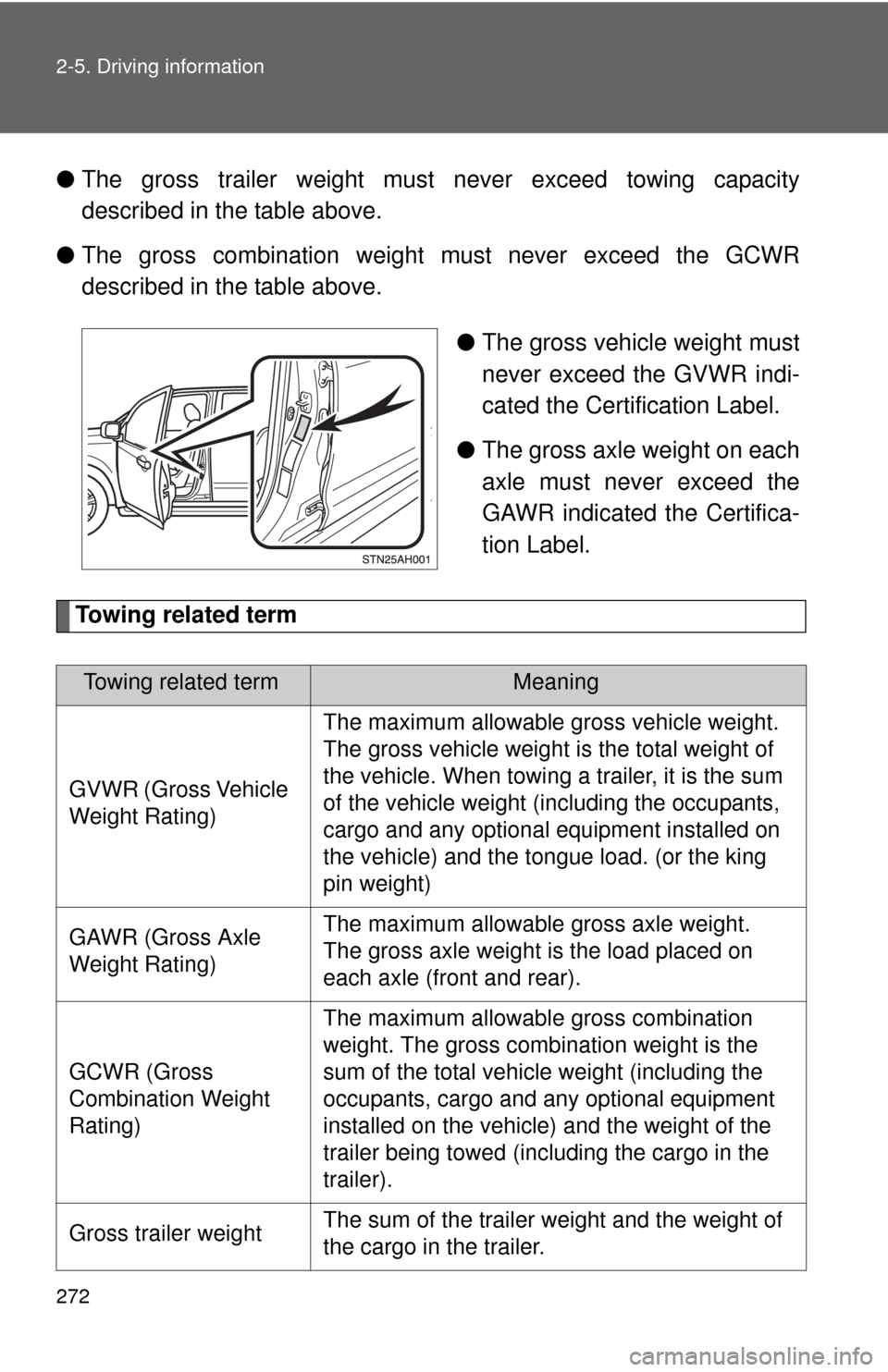
272 2-5. Driving information
●The gross trailer weight must never exceed towing capacity
described in the table above.
● The gross combination weight must never exceed the GCWR
described in the table above.
●The gross vehicle weight must
never exceed the GVWR indi-
cated the Certification Label.
● The gross axle weight on each
axle must never exceed the
GAWR indicated the Certifica-
tion Label.
Towing related term
Towing related termMeaning
GVWR (Gross Vehicle
Weight Rating)
The maximum allowable gross vehicle weight.
The gross vehicle weight is the total weight of
the vehicle. When towing a trailer, it is the sum
of the vehicle weight (including the occupants,
cargo and any optional equipment installed on
the vehicle) and the tongue load. (or the king
pin weight)
GAWR (Gross Axle
Weight Rating)The maximum allowable gross axle weight.
The gross axle weight is the load placed on
each axle (front and rear).
GCWR (Gross
Combination Weight
Rating)
The maximum allowabl e gross combination
weight. The gross combination weight is the
sum of the total vehicle weight (including the
occupants, cargo and any optional equipment
installed on the vehicle) and the weight of the
trailer being towed (including the cargo in the
trailer).
Gross trailer weightThe sum of the trailer weight and the weight of
the cargo in the trailer.
Page 273 of 724
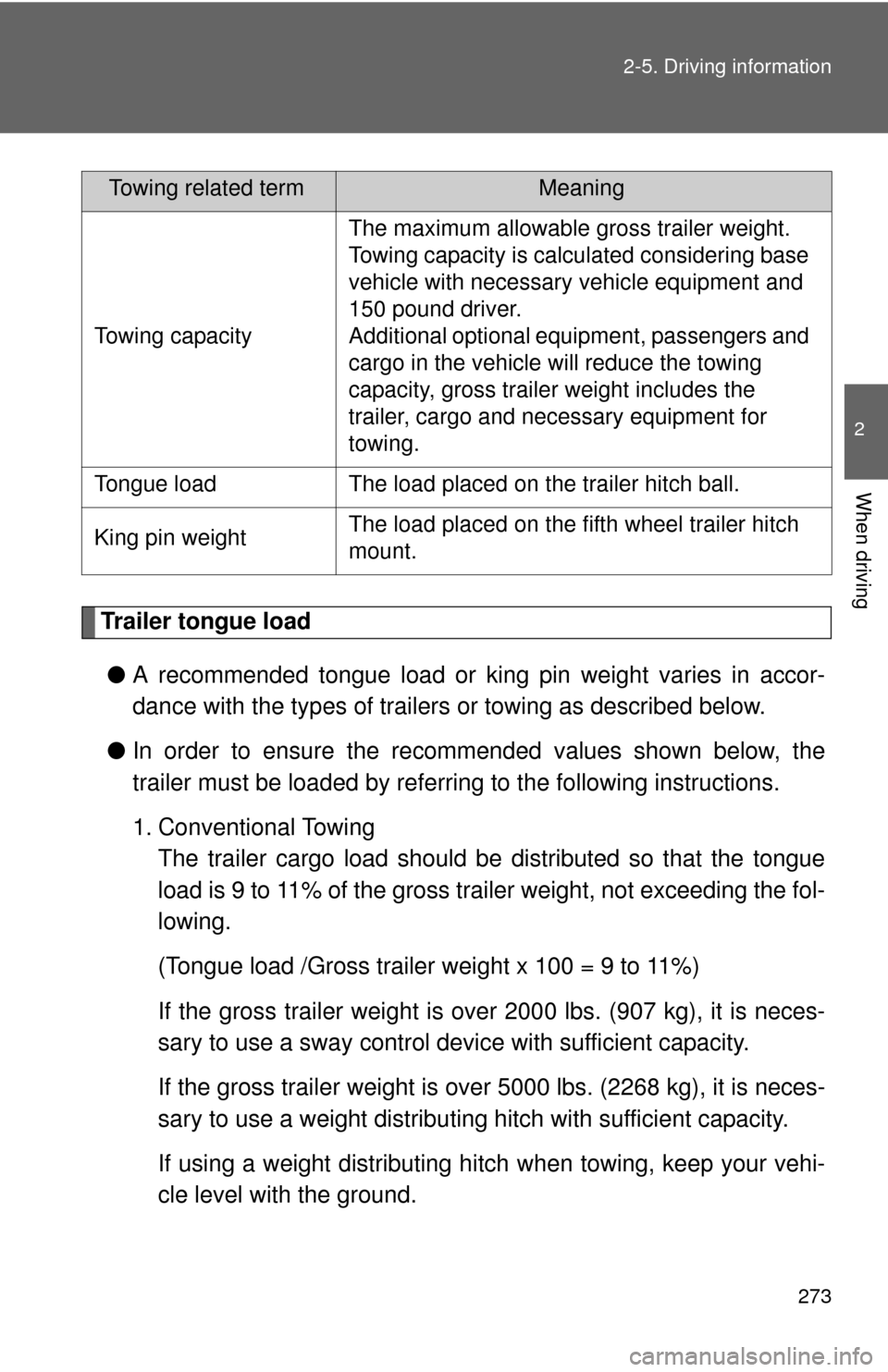
273
2-5. Driving information
2
When driving
Trailer tongue load
● A recommended tongue load or king pin weight varies in accor-
dance with the types of trailers or towing as described below.
● In order to ensure the recommended values shown below, the
trailer must be loaded by referring to the following instructions.
1. Conventional Towing
The trailer cargo load should be distributed so that the tongue
load is 9 to 11% of the gross trailer weight, not exceeding the fol-
lowing.
(Tongue load /Gross trailer weight x 100 = 9 to 11%)
If the gross trailer weight is over 2000 lbs. (907 kg), it is neces-
sary to use a sway control device with sufficient capacity.
If the gross trailer weight is over 5000 lbs. (2268 kg), it is neces-
sary to use a weight distributing hitch with sufficient capacity.
If using a weight distributing hi tch when towing, keep your vehi-
cle level with the ground.
Towing related termMeaning
Towing capacity
The maximum allowable gross trailer weight.
Towing capacity is calculated considering base
vehicle with necessary vehicle equipment and
150 pound driver.
Additional optional equipment, passengers and
cargo in the vehicle will reduce the towing
capacity, gross trailer weight includes the
trailer, cargo and necessary equipment for
towing.
Tongue loadThe load placed on the trailer hitch ball.
King pin weightThe load placed on the fifth wheel trailer hitch
mount.
Page 274 of 724
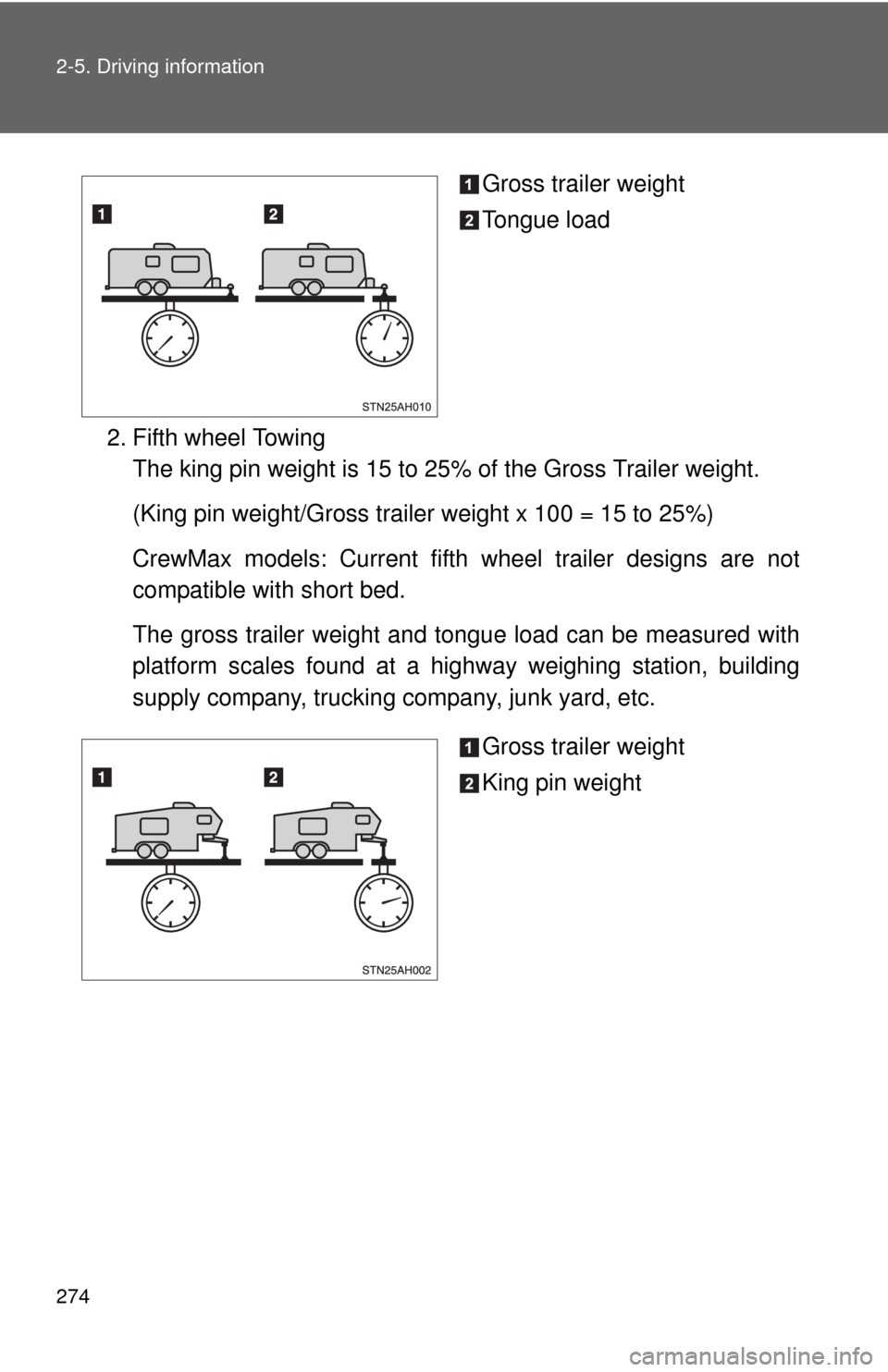
274 2-5. Driving information
Gross trailer weight
Tongue load
2. Fifth wheel Towing The king pin weight is 15 to 25% of the Gross Trailer weight.
(King pin weight/Gross trailer weight x 100 = 15 to 25%)
CrewMax models: Current fifth wheel trailer designs are not
compatible with short bed.
The gross trailer weight and tongue load can be measured with
platform scales found at a high way weighing station, building
supply company, trucking company, junk yard, etc.
Gross trailer weight
King pin weight
Page 275 of 724
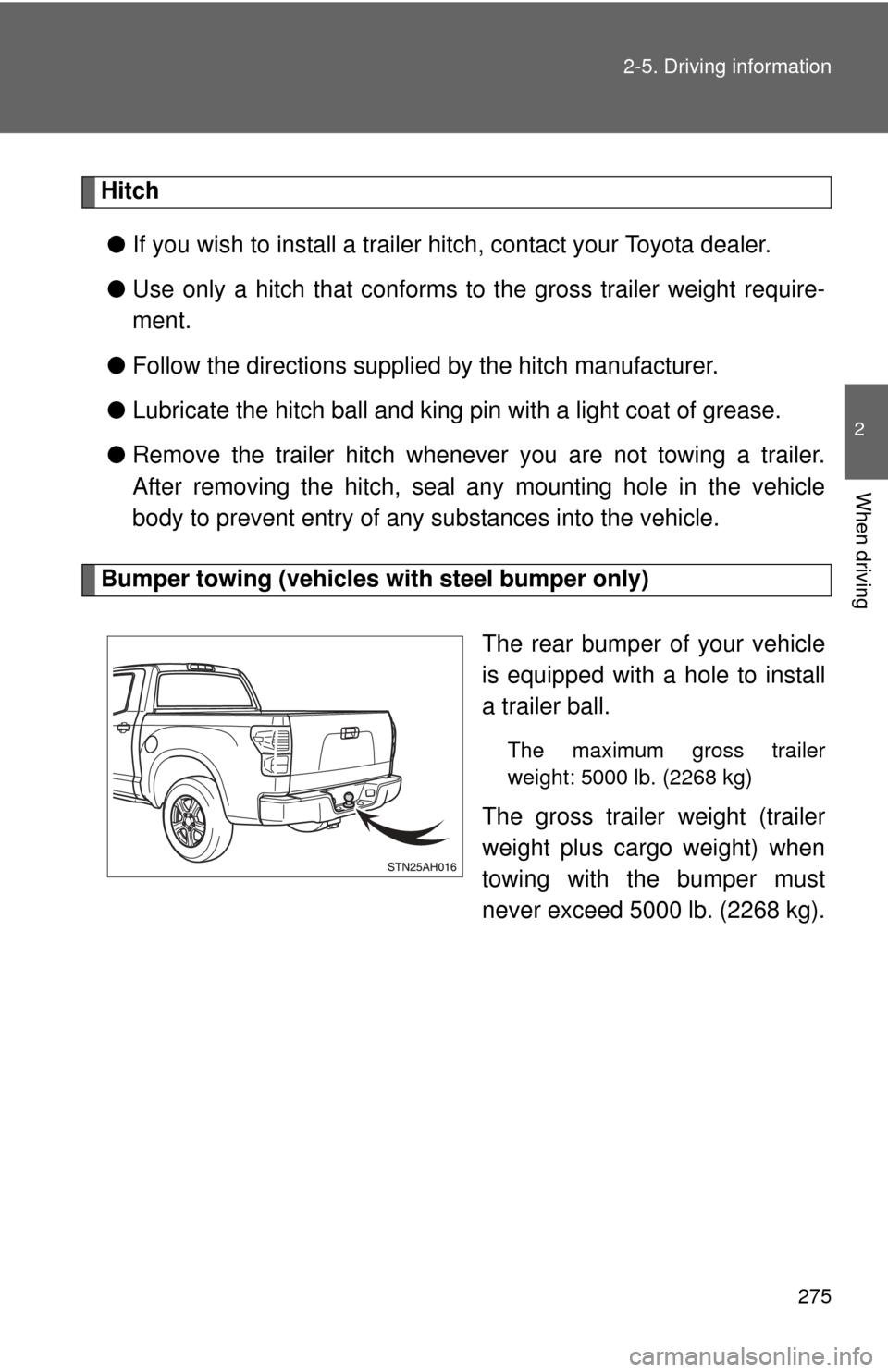
275
2-5. Driving information
2
When driving
Hitch
● If you wish to install a trailer hitch, contact your Toyota dealer.
● Use only a hitch that conforms to the gross trailer weight require-
ment.
● Follow the directions supplied by the hitch manufacturer.
● Lubricate the hitch ball and king pin with a light coat of grease.
● Remove the trailer hitch whenever you are not towing a trailer.
After removing the hitch, seal any mounting hole in the vehicle
body to prevent entry of any substances into the vehicle.
Bumper towing (vehicles with steel bumper only)
The rear bumper of your vehicle
is equipped with a hole to install
a trailer ball.
The maximum gross trailer
weight: 5000 lb. (2268 kg)
The gross trailer weight (trailer
weight plus cargo weight) when
towing with the bumper must
never exceed 5000 lb. (2268 kg).
Page 276 of 724

276 2-5. Driving information
Selecting trailer ballUse the correct trailer ball for your application. Trailer ball load rating
Matches or exceeds the gross
trailer weight rating of the trailer.
Ball diameter
Matches the size of the trailer
coupler. Most couplers are
stamped with the required trailer
ball size.
Shank length
Protrudes beyond the bottom of
the lock washer and nut at least 2
threads.
Shank diameter
Matches the ball mount hole
diameter size.
Trailer
classTypical trailer ball
size
IV2 5/16 in.
II and III2 in.
I1 7/8 in.
Page 277 of 724
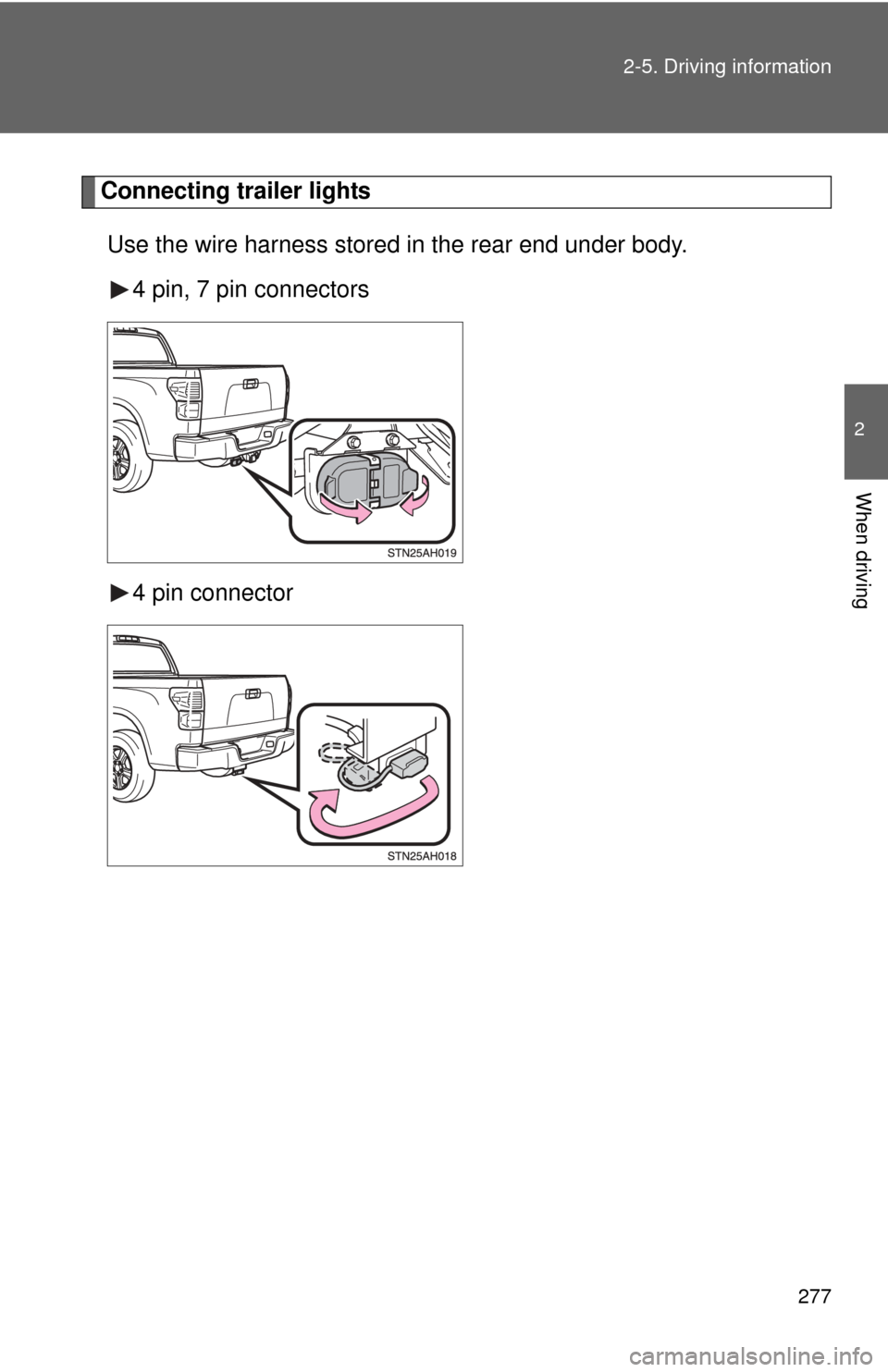
277
2-5. Driving information
2
When driving
Connecting trailer lights
Use the wire harness stored in the rear end under body. 4 pin, 7 pin connectors
4 pin connector
Page 278 of 724

278 2-5. Driving information
Trailer towing tipsYour vehicle will handle differently when towing a trailer. The three
main causes of vehicle-trailer ac cidents are driver error, excessive
speed and improper trailer loading. Keep the following in mind when
towing.
● Speed limits for towing a trailer vary by state or province. Do not
exceed the posted towing speed limit.
● Before starting out, check the trailer’s light and the vehicle-trailer
connections. Recheck after driving a short distance.
● Practice turning, stopping and reve rsing with the trailer attached in
an area away from traffic until you become accustomed to the feel
of the vehicle.
● Reversing with a trailer attached is difficult and requires practice.
Grip the bottom of the steering wheel and move your hand to the
left to move the trailer to the left. Move your hand to the right to
move the trailer to the right. (This is generally opposite to reversing
without a trailer attached.) Avoid sharp or prolonged turning. Have
someone guide you when reversing to reduce the risk of an acci-
dent.
● As stopping distance is increased when towing a trailer, vehicle-to-
vehicle distance should be increased. For each 10 mph (16 km/h)
of speed, allow at least o ne vehicle and trailer length.
● Avoid sudden braking as you may skid, resulting in jackknifing and
loss of control. This is especiall y true on wet or slippery surfaces.
● Avoid jerky starts or sudden acceleration.
● Avoid jerky steering and sharp turns, and slow down before mak-
ing a turn.
● Note that when making a turn, th e trailer wheels will be closer than
the vehicle wheels to the inside of the turn. Compensate by making
a larger than normal turning radius.
Page 279 of 724

279
2-5. Driving information
2
When driving
●
Crosswinds and rough roads will adversely affect handling of your
vehicle and trailer, causing sway . Periodically check the rear to
prepare for being passed by large trucks or buses, which may
cause your vehicle and trailer to sway. If swaying occurs, firmly grip
the steering wheel, reduce speed immediately but gradually, and
steer straight ahead. Never increase speed. If you make no
extreme correction with the stee ring or brakes, your vehicle and
trailer will stabilize.
● Take care when passing other vehicles. Passing requires consider-
able distance. After passing a vehicle, do not forget the length of
your trailer, and be sure you hav e plenty of room before changing
lanes.
● In order to maintain engine braking efficiency when driving on a
long steep downgrade, do not use the transmission in D.
Transmission shift range position must be in 5 in the S mode (6-
speed models) or in 4 in the S mode (5-speed models).
● Due to the added load of the trailer, your vehicle’s engine may
overheat on hot days (at temperatures over 85°F [30°C]) when
driving up a long or steep grade. If the engine coolant temperature
gauge indicates overheating, immedi ately turn off the air condition-
ing (if in use), pull your vehicle off the road and stop in a safe spot.
( P. 634)
● Always place wheel blocks under both the vehicle and the trailer
wheels when parking. Apply the parking brake firmly, and put the
transmission in P. Avoid parking on a slope, but if unavoidable, do
so only after performing the following:
Apply the brakes and keep them applied.
Have someone place wheel blocks under both the vehicle and
trailer wheels.
When the wheel blocks are in pl ace, release the brakes slowly
until the blocks absorb the load.
Apply the parking brake firmly.
Page 280 of 724
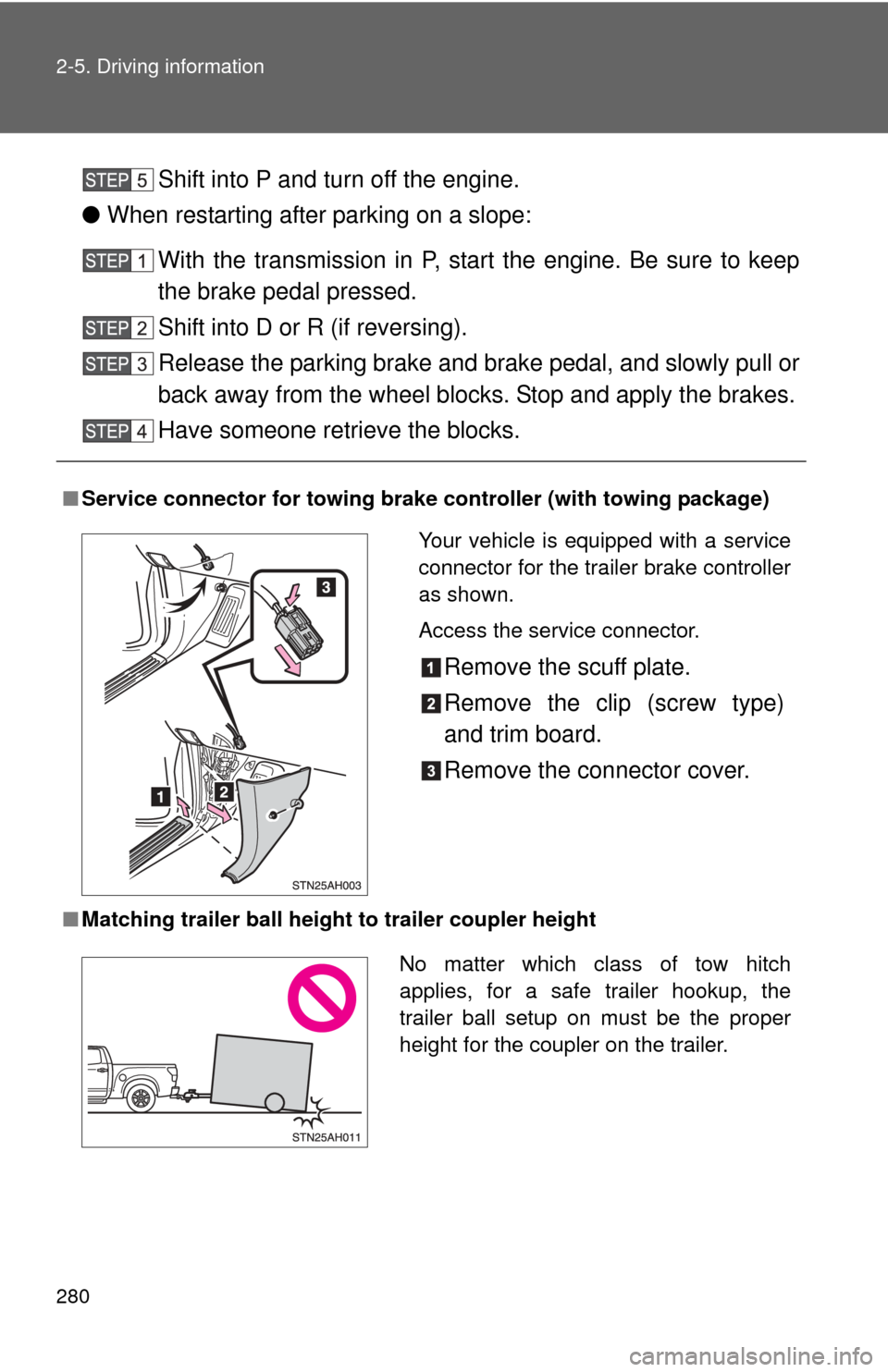
280 2-5. Driving information
Shift into P and turn off the engine.
● When restarting after parking on a slope:
With the transmission in P, start the engine. Be sure to keep
the brake pedal pressed.
Shift into D or R (if reversing).
Release the parking brake and brake pedal, and slowly pull or
back away from the wheel blocks. Stop and apply the brakes.
Have someone retrieve the blocks.
■Service connector for towing br ake controller (with towing package)
■ Matching trailer ball height to trailer coupler height
Your vehicle is equipped with a service
connector for the trailer brake controller
as shown.
Access the service connector.
Remove the scuff plate.
Remove the clip (screw type)
and trim board.
Remove the connector cover.
No matter which class of tow hitch
applies, for a safe trailer hookup, the
trailer ball setup on must be the proper
height for the coupler on the trailer.